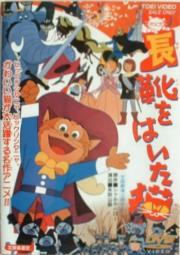The Wonderful World of Puss 'n Boots facts for kids
The Wonderful World of Puss 'n Boots (Japanese: 長靴をはいた猫, Hepburn: Nagagutsu o Haita Neko, literally "Cat Who Wore Boots") is a fun Japanese animated film from 1969. It was made by Toei Animation, a famous animation studio. The movie is an action-comedy musical and was directed by Kimio Yabuki.
The story is based on the classic fairy tale of Puss in Boots by Charles Perrault. But this film adds lots of exciting adventure and funny moments. It also features many other animal characters who act like humans. The main character, the cat, is named Pero, which comes from Perrault's name. This movie was the 15th film made by Toei Animation.
This film is very important because Pero, the cat, became the official mascot and logo for Toei Animation. You can often see his face at the start or end of their animated movies. In 2016, a new 3D logo with Pero was created to celebrate the company's 60th birthday!
Many talented animators worked on this film, including Yasuo Ōtsuka, Reiko Okuyama, and even Hayao Miyazaki. They were given a lot of freedom to create amazing scenes. One famous scene is a chase across castle walls, animated by Ōtsuka and Miyazaki. This scene later inspired similar chases in other famous films like Miyazaki's The Castle of Cagliostro.
Contents
Characters in the Film
| Character | Japanese Voice | English Voice |
|---|---|---|
| Pero | Susumu Ishikawa | Gilbert Mack |
| Pierre | Toshiko Fujita | Jack Grimes |
| Princess Rosa | Rumi Sakakibara | Corinne Orr |
| Assassin | Ado Mizumori | Unknown |
| Little Mouse | Yōko Mizugaki | Unknown |
| Boss Mouse | Kazuo Kumakura | Unknown |
| Daniel | Kenji Utsumi | Ray Owens |
| Raymond | Shun Yashiro | Unknown |
| Assassin Boss | Kinya Aikawa | Unknown |
| Lucifer | Asao Koike | Ray Owens |
| King | Kiiton Masuda | Gilbert Mack |
What Happens in the Story
The main character is a clever cat named Pero. He is declared an outlaw by other cats in his village. Why? Because he saved some mice, which is against the rules for cats! Pero escapes to avoid being punished. The Feline King sends three clumsy assassins to catch him.
Pero starts his journey, always trying to avoid the assassins. Soon, he meets a kind young boy named Pierre. Pierre is a poor miller's son who has been kicked out of his home. Pero and Pierre quickly become good friends and travel together.
They arrive at a busy kingdom where a ceremony is happening. The King wants to find a prince for his lonely daughter, Princess Rosa. Pero thinks Pierre would be perfect and rushes into the castle with a plan. Pierre isn't so sure about it!
But then, a scary sorcerer named Lucifer appears. He shows off his powerful magic. He promises power and riches if Princess Rosa agrees to marry him. The King is excited, but Rosa bravely says no. This makes Lucifer very angry. He threatens the kingdom with darkness if Rosa doesn't marry him in three days. Pero realizes his simple plan has become a much bigger adventure!
Promotional Manga
Hayao Miyazaki, one of the famous animators, also created a 12-chapter manga series. This manga was made to help promote the film. It was printed in color in a Japanese newspaper from January to March 1969. Later, in 1984, the series was released as a small book.
Other Movies in the Series
The 1969 Puss 'n Boots film had two sequels.
The Three Musketeers in Boots (1972)
The second film, called Nagagutsu Sanjūshi (ながぐつ三銃士, "Cavalier-Booted Three Musketeers"), came out in 1972. Even though its title mentions "Three Musketeers," it's actually a Western movie! It's set in the American Old West, not in Europe. In the English version, Pero was renamed Ringo.
Puss 'n Boots Travels Around the World (1976)
The third film is Puss 'n Boots Travels Around the World (長靴をはいた猫 80日間世界一周, Nagagutsu o Haita Neko: Hachijū Nichi-kan Sekaiisshū). It came out in 1976. This movie is about Pero traveling around the world in 80 days, just like the famous book! In its English version, Pero was called Pussty.
This third film was very popular in the Soviet Union, with over 42 million people watching it!
A video game called Nagagutsu o Haita Neko: Sekai Isshū 80 Nichi Dai Bōken was based on this third movie. It was released for the Famicom in Japan. Later, it came out in other countries as Puss 'n Boots: Pero's Great Adventure. The game's story was even used in an episode of the TV show Captain N: The Game Master.
Short Film "Dream"
In 2018, Toei Animation made a short film that was only 6 minutes long. It was called "Dream." In this short film, a young boy dreams about whales, and Pero also appears in his dream! This version of Pero had slightly different eyes to match the short film's animation style.
See also
 In Spanish: El Gato con Botas (pel%C3%ADcula de 1969) para ni%C3%B1os
In Spanish: El Gato con Botas (pel%C3%ADcula de 1969) para ni%C3%B1os


